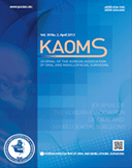Journal of the Korean Association of Oral and Maxillofacial Surgeons
- P-ISSN2234-7550
- E-ISSN2234-5930
- SCOPUS, KCI, ESCI
 ISSN : 2234-7550
ISSN : 2234-7550
Long-term clinical study of fixed prosthetic rehabilitation using one-piece narrow-diameter implants: a retrospective study
Jung Hyun Nam (Department of Prosthodontics, Section of Dentistry, Seoul National University Bundang Hospital, Seongnam,)
Na-Hee Chang (Department of Dental Hygiene, Section of Dentistry, Gangdong University, Eumseong)
Yang-Jin Yi (Department of Prosthodontics, Section of Dentistry, Seoul National University Bundang Hospital, Seongnam)
Abstract
Objectives: The objective of this study was to evaluate the long-term clinical outcomes of one-piece narrow-diameter implants (NDIs), with diameters of 2.5 mm and 3.0 mm, and to investigate the factors that affect marginal bone loss (MBL) around these implants. Materials and Methods: This study analyzed patients who were treated with 2.5 mm and 3.0 mm MS SA narrow ridge implants (Osstem Implant) at the Section of Dentistry in Seoul National University Bundang Hospital from 2007 to 2022 and had more than 6 years of follow-up data. MBL was measured using periapical radiographs. Age, sex, implant location, timing of implant placement and loading, placement depth, guided bone regeneration (GBR), fixture diameter, type of implant prosthesis, and opposing dentition type were investigated in relation to MBL. The implant survival rate was analyzed using Kaplan–Meier survival curves, and univariate and multivariate logistic regression models were used to identify factors associated with MBL. All analyses were conducted using R software (version 4.1.0 for Microsoft Windows; R Foundation). Results: Twenty-five patients with 40 NDIs were included in this study. The mean observation period after implant function was 10.5 years (range, 6.1 to 14.0 years), and the survival rate of the NDIs was 95.1% at the implant level and 96.0% at the patient level. The average amount of MBL was 0.44±0.57 mm. The only factor that showed a significant association with MBL was the presence of GBR (P=0.046). Conclusion: Within the limitations of a retrospective evaluation, NDIs have demonstrated optimal clinical outcomes over a long period in areas in which anatomical structures are limited. MBL around the NDI also showed clinically acceptable results, and a correlation with MBL was observed in cases in which a bone graft was performed. Further studies with a larger number of implants over extended periods are needed in the future.
- keywords
- Dental implants, Narrow-diameter implant, Alveolar bone loss, Survival rate
- Downloaded
- Viewed
- 0KCI Citations
- 0WOS Citations